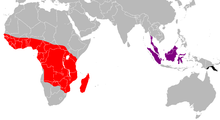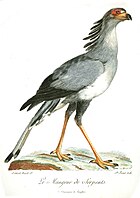Bat hawk
 From Wikipedia - Reading time: 9 min
From Wikipedia - Reading time: 9 min
| Bat hawk | |
|---|---|

| |
| Bat hawk at Cape Vidal, northern Natal, South Africa | |
| Scientific classification | |
| Domain: | Eukaryota |
| Kingdom: | Animalia |
| Phylum: | Chordata |
| Class: | Aves |
| Order: | Accipitriformes |
| Family: | Accipitridae |
| Genus: | Macheiramphus Bonaparte, 1850 |
| Species: | M. alcinus
|
| Binomial name | |
| Macheiramphus alcinus Bonaparte, 1850
| |
| Subspecies | |
|
M. a. anderssoni
M. a. alcinus
M. a. papuanus
| |

| |
| Synonyms | |
|
Machaerhamphus alcinus Westerman, 1851 | |
The bat hawk (Macheiramphus alcinus) is a raptor found in sub-Saharan Africa and south Asia to New Guinea. It is named for its diet, which consists mainly of bats.[2] It requires open space in which to hunt, but will live anywhere from dense rainforest to semi-arid veld.
Description
[edit]The bat hawk is a slender, medium-sized bird of prey, usually about 45 cm long. It has long wings and a falcon-like silhouette while in flight. Adults are dark brown or black, with a white patch on the throat and chest, and have a white streak above and below each eye. Juveniles are mottled brown and have more white plumage than adults.
Behaviour
[edit]Hunting
[edit]Bats are the usual prey of the bat hawk, although they may eat small birds, such as swallows, swifts, and nightjars, or even insects. They hunt by chasing their prey at high speeds in flight. 49.3% of their hunts are successful. Bats are captured by the use of small talons, and swallowed whole immediately in flight. Hunting methods may be similar to that of Swainson's Hawk, which makes use of different approach types (Up-stream, Down-stream and cross-stream) and grab directions/body positions (pitch down, pitch up and roll manoeuvres) to capture prey in a swarm.[3] Bat hawks also show very rapid ingestion rates, taking on average 6 seconds for the prey to reach the stomach after capture.[4]
The bat hawk is crepuscular and hunts at dusk. They can be observed perching near a cave/bat dwelling prior to dusk emergence.[5] They feed on the wing and swallow their prey whole. This feeding habit has resulted in the evolution of an unusually large gape, the largest of any raptor relative to body size, and is more similar to that of insectivorous birds which feed on the wing such as swallows, swifts and nightjars.[6] The evolution of a large gape is likely due to the selective pressure of a limited feeding time. Since bats only emerge at dusk in swarms, a temporal window of ±30 minutes is allotted for bat hawks to hunt. A large gape allows the hawks to feed extremely rapidly, often with multiple captures per hunting bout.[7]
The crepuscular habits, large gape and in-flight manoeuvrability makes the bat hawk well adapted for its choice of prey hunting. This ecological niche is highly exploited by bat hawks, making their competition with other diurnal raptors minimal.[4]
Breeding
[edit]Courtship involves many aerial displays and stunts. The nest is built with sticks gathered in flight, and is about 90 cm across and 30 cm deep.[8] The female is solely responsible for incubating her clutch. The male often shares food with her. About a month after incubation begins, the eggs hatch, and both parents help to feed their young. 30–45 days after hatching, the young fledge. They leave the nest soon after. Bat hawks time their breeding cycles with those of bats, taking advantage of lethargic pregnant females in order to attain breeding condition, whereas fledglings take advantage of young bats which have recently taken to the air.[9]
Bat hawks breed most years.
Conservation
[edit]Due to its large range and relatively stable population, the bat hawk is of least concern.[1] However, localized populations are under threat, and it is listed as Endangered in South Africa.[10]
Etymology
[edit]The genus name is from Greek: μαχαιρα makhaira meaning knife; and ῥαμφος rhamphos, bill. The specific epithet alcinus means like an auk, from Linnaeus' genus Alca, which is also a reference to the bat hawk's thin bill.[11]
Taxonomy
[edit]The spelling of the genus name is problematic. Charles Lucien Bonaparte described the bat hawk in 1850, naming it Macheiramphus alcinus.[12]: 482–483 Westerman described it in 1851 under the name Machaerhamphus alcinus, and this form was used for over a hundred years because it was believed to have been published in 1848. In 1960 Deignan pointed out that Bonaparte has priority, but in 1979 Amadon claimed that Macheiramphus alcinus is an abandoned name. Brooke and Clancey note that the preservation of a junior synonym requires a special ruling from the ICZN that Amadon didn't obtain; whilst Dickinson argues that Deignan's resurrection of the name in 1960 should stand because it predates the first edition of the Code in 1961.[13][14]
References
[edit]- ^ a b BirdLife International (2016). "Macheiramphus alcinus". IUCN Red List of Threatened Species. 2016: e.T22695021A93485278. doi:10.2305/IUCN.UK.2016-3.RLTS.T22695021A93485278.en. Retrieved 19 November 2021.
- ^ Mikula, P., Morelli, F., Lučan, R. K., Jones, D. N., & Tryjanowski, P. (2016). Bats as prey of diurnal birds: a global perspective. Mammal Review.
- ^ Brighton, Caroline H; Zusi, Lillias; McGowan, Kathryn A; Kinniry, Morgan; Kloepper, Laura N; Taylor, Graham K (2021-06-04). Quinn, John (ed.). "Aerial attack strategies of hawks hunting bats, and the adaptive benefits of swarming". Behavioral Ecology. 32 (3): 464–476. doi:10.1093/beheco/araa145. ISSN 1045-2249. PMC 8177810. PMID 34104109.
- ^ a b Black, H. L.; Howard, G.; Stjernstedt, R. (1979). "Observations on the Feeding Behavior of the Bat Hawk (Macheiromphus alcinus)". Biotropica. 11 (1): 18–21. Bibcode:1979Biotr..11...18B. doi:10.2307/2388165. JSTOR 2388165.
- ^ Black, H. L.; Howard, G.; Stjernstedt, R. (1979). "Observations on the Feeding Behavior of the Bat Hawk (Macheiromphus alcinus)". Biotropica. 11 (1): 18–21. Bibcode:1979Biotr..11...18B. doi:10.2307/2388165. ISSN 0006-3606. JSTOR 2388165.
- ^ Jones, Landon R.; Black, Hal L.; White, Clayton M. (2012). "Evidence for Convergent Evolution in Gape Morphology of the Bat Hawk (Macheiramphus alcinus) with Swifts, Swallows, and Goatsuckers". Biotropica. 44 (3): 386–393. Bibcode:2012Biotr..44..386J. doi:10.1111/j.1744-7429.2011.00812.x. JSTOR 41496010. S2CID 83874450.
- ^ Jones, Landon R.; Black, Hal L.; White, Clayton M. (May 2012). "Evidence for Convergent Evolution in Gape Morphology of the Bat Hawk (Macheiramphus alcinus) with Swifts, Swallows, and Goatsuckers: Bat Hawk Gape". Biotropica. 44 (3): 386–393. Bibcode:2012Biotr..44..386J. doi:10.1111/j.1744-7429.2011.00812.x. S2CID 83874450.
- ^ The Hawk Conservancy Trust (1996-2007). Bat Hawk. Retrieved April 16, 2007, from http://www.hawk-conservancy.org/priors/bathawk.shtml
- ^ Hartley, R; Hustler, K (1993). "A less-than-annual breeding cycle in a pair of African Bat Hawks Machaeramphus alcinus". Ibis. 135 (4): 456–458. doi:10.1111/j.1474-919X.1993.tb02119.x.
- ^ "Welcome to BirdLife South Africa - BLSA Threatened Species Birdlasser Cause". www.birdlife.org.za. Archived from the original on 2016-04-28.
- ^ Jobling, James A. (2014). "Key to Scientific Names in Ornithology". Handbook of the Birds of the World Alive. Lynx Edicions. Retrieved 31 October 2014. See entries Machieramphus and alcinus.
- ^ Bonaparte, Charles-Lucien (1850). "Revue générale de la classe des oiseaux". Revue et Magasin de Zoologie Pure et Appliquée (in French). 2 (2): 474–492. Retrieved 31 October 2014.
- ^ Brooke, R. K.; Clancey, P. A. (1981). "The Authorship of the Generic and Specific Names of the Bat Hawk". Bulletin of the British Ornithologists' Club. 101 (4): 371–372. Retrieved 21 July 2017.
- ^ Peterson, Alan P. (2013). "Zoonomen Nomenclatural data". Retrieved 28 October 2014.
 KSF
KSF


